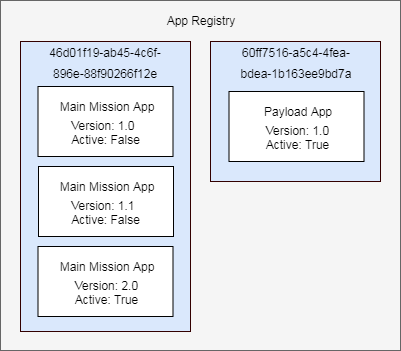Kubos Applications Service¶
The Kubos applications service is responsible for monitoring and managing all mission applications for a system.
Whenever a new application is registered with the service, its manifest file and all other files in the specified directory are copied into the service’s application registry. By default, this registry is stored under /home/system/kubos/apps.
Each application will be automatically assigned a UUID to be used for identification purposes internally. Using UUIDs, rather than the application’s name, allows users the freedom to adjust the application name as they see fit, for instance if the overall purpose of the application changes and they would like to update the name to reflect that in later versions.

Communicating with the Service¶
The applications service uses the same HTTP+GraphQL communication scheme as the other services.
Users will send GraphQL queries and mutations to the service’s HTTP listener port. The port number can be found in the systems configuration file in /home/system/etc/config.toml
Querying¶
A current list of all available versions of all registered applications can be generated by using the apps query.
For example:
{
apps {
active,
app {
uuid,
name,
version
}
}
Using our example registry, the data returned by the service would be:
{
"apps": [
{
"active": false,
"app": {
"uuid": "46d01f19-ab45-4c6f-896e-88f90266f12e",
"name": "main-mission",
"version": "1.0"
}
},
{
"active": false,
"app": {
"uuid": "46d01f19-ab45-4c6f-896e-88f90266f12e",
"name": "main-mission",
"version": "1.1"
}
},
{
"active": true,
"app": {
"uuid": "46d01f19-ab45-4c6f-896e-88f90266f12e",
"name": "main-mission",
"version": "2.0"
}
},
{
"active": true,
"app": {
"uuid": "60ff7516-a5c4-4fea-bdea-1b163ee9bd7a",
"name": "payload-app",
"version": "1.0"
}
},
]
}
To list all available versions of a specific application, specify the desired UUID as an input parameter.
For example:
{
apps(uuid: "60ff7516-a5c4-4fea-bdea-1b163ee9bd7a") {
app {
name,
version
}
}
}
Registering¶
Once an application has been written and compiled, the application and its accompanying manifest.toml file should be transferred to a new directory on the OBC. This file transfer can be done using the file transfer service.
The application may be split into multiple files (which is useful for large Python apps), however,
the name of the initial file which should be called for execution must exactly match the name
property in the manifest file.
It can then be registered with the applications service using the register mutation by specifying
the directory containing the application files.
The service will copy the application from the specified path into the apps registry. Once registered, users may delete the original application.
For example:
mutation {
register(path: "/home/kubos/payload-app") {
success,
errors,
entry {
active,
app {
name,
version
}
}
}
}
The success response field is a boolean value which reflects whether the registration process
completed successfully.
If true, then the entry field will contain the registration information about the newly
registered application.
If false, then the entry field will be empty, and the errors field will contain an
error message detailing what went wrong.
De-Registering¶
A particular version of an application can be removed using the uninstall mutation.
The mutation returns two fields:
success- Indicating the overall result of the uninstall operationerrors- Any errors which were encountered during the uninstall process
For example:
mutation {
uninstall(uuid: "46d01f19-ab45-4c6f-896e-88f90266f12e", version: "1.1") {
success,
errors
}
}
Starting an Application¶
To manually start an application, the startApp mutation can be used.
The mutation takes two arguments: the UUID of the application to start and the run level which the app should execute with.
The mutation will return three fields:
success- Indicating the overall result of the operationerrors- Any errors which were encountered while starting the applicationpid- The PID of the started application. This will be empty if any errors are encountered
For example:
mutation {
startApp(uuid: "60ff7516-a5c4-4fea-bdea-1b163ee9bd7a", runLevel: "OnCommand") {
success,
errors,
pid
}
}
Under the covers, the service receives the mutation and identifies the current active version of the application specified. It then calls that version’s binary, passing along the run level as a command argument.
Passing Additional Arguments¶
To pass additional arguments to the underlying application, the args input argument can be used.
For example:
mutation {
startApp(uuid: "60ff7516-a5c4-4fea-bdea-1b163ee9bd7a", runLevel: "OnCommand", args: "--verbose --release") {
success
}
}
Under the covers, the application would be called like so:
mission-app -r OnCommand --verbose --release
Automatically Starting on Boot¶
All applications will be started with the OnBoot run level automatically when the applications service is
started during system initialization.
This logic may also be triggered by manually starting the applications service with the -b flag.
Upgrading¶
Users may register a new version of an application without needing to remove the existing registration.
To do this, they will use the register mutation with the optional uuid input parameter.
An application’s UUID is given as a return field of the register mutation and can also be looked up
using the apps query.
mutation {
register(path: /home/kubos/payload-app, uuid: 60ff7516-a5c4-4fea-bdea-1b163ee9bd7a) {
active,
app {
name,
version
}
}
}
Customizing the Applications Service¶
The configuration for the applications service is saved in /home/system/etc/config.toml. This file can be editted to add or modify the following fields:
[app-service.addr]ip- The IP address that the service will useport- The port GraphQL requests should be sent to
[app-service]registry-dir- (Default: /home/system/kubos/apps) The directory under which all registry entries should be stored